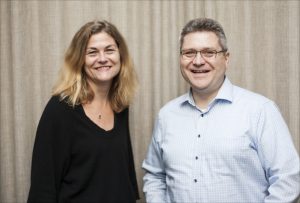International Gaucher Alliance Created to Advocate for Patients’ Needs, Including Better Diagnosis and Care
Written by |

IGA delegates meet Oct. 15-17 in Riga, Latvia. (Photo courtesy IGA)
Delegates from 48 countries have established the International Gaucher Alliance (IGA) with the goal of working toward “a world where all Gaucher disease patients have access to the treatment and care they need — and the possibility of a cure.”
Meeting Oct. 15-17 in the Latvian capital of Riga, advocates formed the IGA — an outgrowth of the European Gaucher Alliance (EGA) — to speak for Gaucher patients worldwide, to ensure that the Gaucher research agenda focuses on patients’ unmet needs, and to help patients access early diagnosis as well as optimal treatment and care.
Tanya Collin-Histed, the organization’s full-time CEO, said that the organization that eventually became EGA has been helping Gaucher patients lacking access to needed treatments since 1994, by working with pharmaceutical companies to develop charitable access programs.
“In the early 2000s, together with patient representatives from Russia, Ukraine, Bulgaria and Romania, the EGA took on the role of negotiating for humanitarian aid with Genzyme,” Collin-Histed said in a statement emailed to Gaucher Disease News. “In 2004, the company began a European Cerezyme access program, which provides free treatment for severely affected patients whose health services cannot or will not meet the cost of treatment.”
Gaucher affects about one in 60,000 people, and is particularly common among Jews of Ashkenazi, or European, descent. The cost of enzyme replacement therapy is about $200,000 annually.
To date, 117 patients in 14 countries have benefited from the EGA initiative, which supplies Cerezyme (imiglucerase) — an enzyme replacement therapy marketed by Sanofi Genzyme — to patients who need it.
Database links patients, drug firms
In the past two years, the EGA has received 63 direct requests for treatment from 20 countries. Such requests are recorded in the EGA database, which was set up in 2015 to help notify pharmaceutical companies of these patients and identify countries where local Gaucher patients might be available for clinical trials.
In addition, the IGA participates in the Shire Global Charitable Access Program, which involves 35 patients. Over the past two years, the organization has also worked with Denmark’s Orphazyme to identify patients for that company’s Phase 2 clinical trial (NCT03746587) of arimoclomol. As a result, 40 Gaucher patients with types 1 and 3 will be treated at eight sites in India.
While European countries comprise most of the IGA’s 48 members, the U.K.-based alliance also includes nations such as Canada, China, India, Israel, Japan, Mexico, Pakistan, South Africa, Morocco, and the United States.
Germany’s Pascal Niemeyer became involved with the alliance in 2006, a few years after his infant daughter, Félise, was diagnosed with Gaucher type 3. Despite enzyme replacement therapy that dramatically reduced the size of her enlarged spleen and liver, Félise never learned how to walk, and her movements were limited. Over time, the child’s health worsened.
“She suffered from fits and seizures which were not treatable. She could not swallow or eat normally. It was impossible to feed her and more importantly, she was not able to take her drugs anymore,” said Niemeyer, chairman of the IGA. “The physicians recommended a feeding tube, but as her neurological problems were out of control, Félise was fitted with a vagus nerve stimulator to help control the epilepsy. By this time, the disease was so far advanced that even this intervention could not help her.”
Félise died a few weeks after her fifth birthday.
“When parents see their child pass away, they might find themselves lost in a deep hole,” Niemeyer said. “My way of overcoming my grief was to engage myself with other patients suffering from Gaucher disease, with the hope of at least helping them, as I was not able to help my own daughter.”
Alliance ‘treats patients like family’
Collin-Histed’s story is more encouraging. The British woman’s 2-year-old daughter, Maddie, was diagnosed with neuronopathic (type 2) Gaucher disease in January 1996.
“We were told she would only have a few years to live,” Collin-Histed said. “I set out to learn everything I could, and spent seven years as a volunteer with the UK Gauchers Association with a focus on supporting patients and their families. My driving force here was to bring people together, to empower them with information and ensure that they never felt alone.”
Today, Maddie is a 24-year-old earning a master’s degree in international development at the University of Bath. She’s also a member of the UK Gauchers Association board and a young patient ambassador.
“Being born in the UK, my daughter and others like her had access to treatment and good clinical care,” Collin-Histed said. “I wanted to make sure that wherever other patients in the world lived, they too could have hope for a future and never feel alone — to know there’s someone out there who cares. Even though you may never meet them, they will always be there for you, even when you feel helpless and feel you have nowhere to go.”
Czech patient Markéta Smočová says the IGA is particularly important for new Gaucher patients who may not understand the disease and its symptoms. “We can help them, because we can share experiences from other countries, as well as provide them with information from pharmaceutical companies, doctors and other resources,” she said.
“The IGA treats every member like family, through support and empowerment. This is why it is so successful,” said Aimee-Kate Bosch of South Africa.
Added Vesna Aleksovska of Macedonia, a 33-year-old Gaucher patient who attended her first European Gaucher Alliance meeting in 2012: “I felt overwhelmed. It was like meeting my long-lost family. It encouraged me to do more in Macedonia not just for Gaucher but for all rare diseases, since we had nothing. We were invisible. Today, the picture is completely different.”





